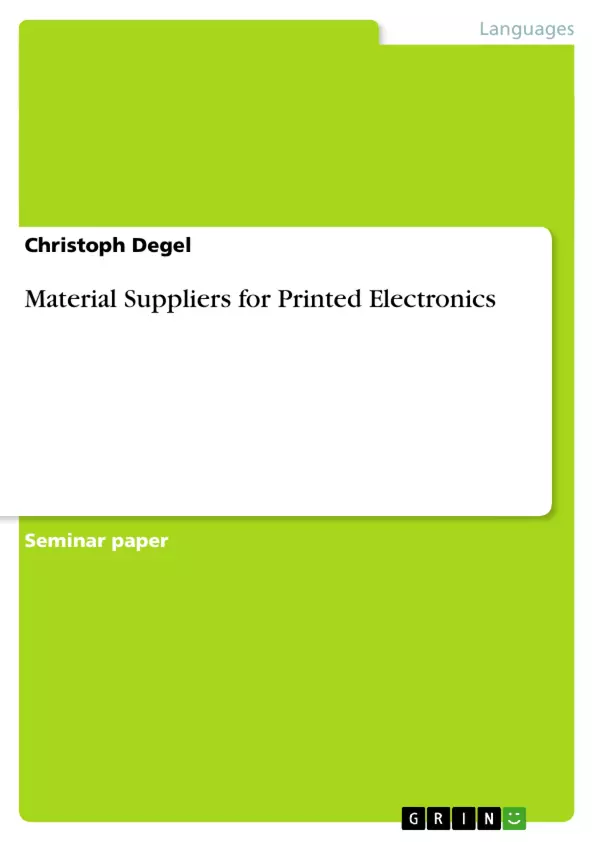Organic and printed electronics are two very recent but well developed technologies.
Thanks to an optimistic road map and cooperations, companies all over the world are doing their best to gain process in the areas of techniques, processes, equipment, applications and materials. Every progress and development in these fields serve one common goal: to improve flexible, thin, lightweight and low cost electronic devices.
In order to achieve all these goals it is very important to have the best and most advanced materials.
My further paper will show different types of materials with their special demands to both material suppliers as well as R & D institutes.
Inhaltsverzeichnis (Table of Contents)
- Introduction
- Materials for Printed Electronics
- Conductors
- Metal Oxides
- Conductive Polymers
- Metal Conductors
- Dielectrics
- Semiconductors
- Substrates
- Conductors
- State-of-the-Art Material Suppliers
- Bayer Material Science AG
- BASF Future Business GmbH
- Agfa-Gevaert NV ORGACON ELECTRONIC MATERIALS
- Evonik Degussa GmbH
- H.C. Stark Clevios GmbH
- State-of-the-Art R&D Institutes
- Fraunhofer Institutes
- Fraunhofer POLO
- Fraunhofer Institute for Applied Polymer Research
- Fraunhofer Institute for Photonic Microsystems
- Sunchon National University
- Fraunhofer Institutes
Zielsetzung und Themenschwerpunkte (Objectives and Key Themes)
This paper aims to provide an overview of the materials used in printed electronics, focusing on their technical properties and the role of both material suppliers and research and development (R&D) institutes in advancing the field.- The importance of materials in achieving flexible, thin, lightweight, and low-cost electronic devices
- Different types of conductive materials used in printed electronics, including metal oxides, conductive polymers, and metal conductors
- The role of dielectrics and semiconductors in printed electronics
- The use of flexible substrates in printed electronics
- The contributions of leading material suppliers and R&D institutes in the field
Zusammenfassung der Kapitel (Chapter Summaries)
- Introduction: This chapter introduces the concept of organic and printed electronics as emerging technologies, emphasizing their potential for creating flexible, thin, lightweight, and cost-effective electronic devices. The chapter highlights the crucial role of materials in achieving these goals.
- Materials for Printed Electronics: This chapter explores the diverse range of materials used in printed electronics, focusing on conductors, dielectrics, semiconductors, and substrates. It details the unique properties and applications of each material type.
- State-of-the-Art Material Suppliers: This chapter introduces prominent companies in the printed electronics materials sector, highlighting their contributions to the field. It emphasizes the importance of collaboration and knowledge exchange among these companies to drive innovation.
Schlüsselwörter (Keywords)
The primary focus of this text is the role of materials in the development and advancement of printed electronics. Key areas of exploration include conductors, dielectrics, semiconductors, substrates, material suppliers, and R&D institutes. The text explores the unique properties and applications of these materials, highlighting the ongoing collaboration and innovation within the printed electronics industry.- Arbeit zitieren
- Christoph Degel (Autor:in), 2010, Material Suppliers for Printed Electronics, München, GRIN Verlag, https://www.hausarbeiten.de/document/146955


